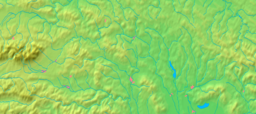Késmárk
| Kežmarok | ||
| Town | ||
|
||
| Name origin: "cheese market" | ||
| Country | Slovakia | |
|---|---|---|
| Region | Prešov | |
| District | Kežmarok | |
| Tourism region | Tatry | |
| River | Poprad | |
| Elevation | 626 m (2,054 ft) | |
| Coordinates | 49°08′01″N 20°25′35″E / 49.13361°N 20.42639°ECoordinates: 49°08′01″N 20°25′35″E / 49.13361°N 20.42639°E | |
| Area | 24.83 km2 (9.59 sq mi) | |
| Population | 16,636 (31 December 2014) | |
| Density | 670/km2 (1,735/sq mi) | |
| First mentioned | 1251 | |
| Mayor | Ján Ferenčák | |
| Timezone | CET (UTC+1) | |
| - summer (DST) | CEST (UTC+2) | |
| Postal code | 06001 | |
| Area code | +421-52 | |
| Car plate | KK | |
| Website: www.kezmarok.sk | ||
| Sources: | ||
Kežmarok (German: Kesmark/Käsmark, Hungarian: Késmárk, Polish: Kieżmark, Latin: Kesmarkium) is a town in the Spiš region of eastern Slovakia (population 17,000), on the Poprad River.
Settlement at Kežmarok dates back to the Upper Stone Age. In the 13th century the region contained a community of Saxons, a Slovak fishing village, a Hungarian border post and a Carpathian German settlement. Its Latin name was first mentioned in 1251 as Villa (Saxonum apud Ecclesiam) Sancte Elisabeth. In 1269 Kežmarok received its town charter. It also had the right to organize a cheese market (hence the German name Kesmark ("Käsemarkt" - "cheese market"). In 1433 the town was severely damaged by a Hussite raid. After 1440, the count of Spiš had a seat in Kežmarok. In the 15th century (and then once more in 1655), Kežmarok became a free royal town.
The town was a stronghold of the noble Thököly family. The Hungarian magnate and warrior Imre Thököly was born in the town in 1657. He died in exile in Turkey in 1705 but in the 20th century his body was returned to Kežmarok and he is buried in a noble mausoleum in the town's Lutheran church.
The town's other monuments include a castle, many Renaissance merchant houses, and a museum of ancient books. In pride of place is the Protestant church built in 1688 entirely of wood. The church also contains an organ of 1719 with wooden pipes. The church has been a UNESCO World Heritage Site since 2008.
...
Wikipedia






